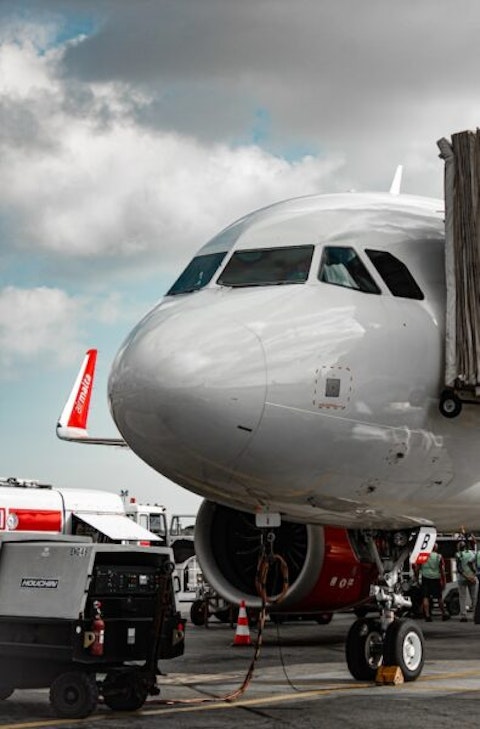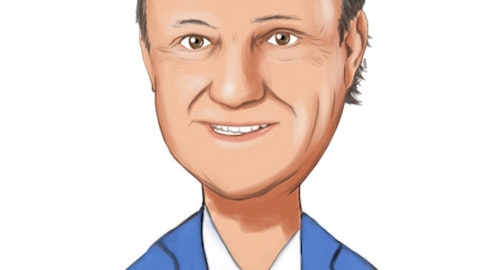Forward Air Corporation (NASDAQ:FWRD) Q4 2022 Earnings Call Transcript February 9, 2023
Operator: Thank you for joining Forward Air Corporation’s Fourth Quarter 2022 Earnings Release Conference Call. Before we begin, I’d like to point out that both the press release and webcast presentation for this call are accessible on the Investor Relations section of Forward Air’s website at www.forwardaircorp.com. With us this morning are CEO, Tom Schmitt; and CFO, Rebecca Garbrick. By now, you should have received the press release announcing our fourth quarter 2022 results, which was furnished to the SEC on Form 8-K and on the wire yesterday after the market close. Please be aware that certain statements in the company’s earnings press release announcement and on this conference call are forward-looking statements within the meaning of the Private Securities Litigation Reform Act of 1995, including statements, which are based on expectations, intentions and projections regarding the company’s future performance, anticipated events or trends and other matters that are not historical facts, including statements regarding our expected first quarter 2023 and fiscal year 2023.
These statements are not a guarantee of future performance and are subject to known and risks, uncertainties and other factors that could cause actual results to differ materially from those expressed or implied by such forward-looking statements. For additional information concerning these risks and factors, please refer to our filings with the Securities and Exchange Commission and the press release and webcast presentation relating to this earnings call. The company undertakes no obligation to update any forward-looking statements, whether as a result of new information, future events or otherwise. During the call, there may also be discussion of financial metrics that do not conform to U.S. Generally Accepted Accounting Principles or GAAP.
Definitions and reconciliations of these non-GAAP measures to their most directly comparable GAAP measures are included in the press release issued, which is available in the Investors tab of our website. And now I’ll turn the call over to Tom Schmitt, CEO of Forward Air.
Thomas Schmitt: Thank you, Brad, and good morning to all of you on the call. First things first, a big thank you to all of our teammates, our independent contractor drivers and our business partners, you did keep our commitment to the best service in the industry with the most intact damage-free LTL shipments. And I thank you for that. You also delivered a record year in all of our lines of business, top line, bottom line with EPS year-over-year growth by almost 70%. So that’s top of the class in our space. Now still, we did not finish the year the way we expected, and we need to address that. In contrast to many of our peers, we had guided to Q4 to be sequentially better than Q3, and our peak planning efforts with our customers actually supported that guidance.
We always pull our top 25 customers or even more going into the fourth quarter, and we felt good about the guidance that we gave. Well, it turned out we have no monopoly to wisdom and not even in concert with our customers as we plan together. We had modeled that the Forward 23 actions that we control would more than make up for the shortfall in demand, the overall sluggishness in the economy and also for fuel coming down. Where we ended up though was with the LTL tonnage going down by 13% in the fourth quarter, way more than the single-digit decline we and frankly, we, together with our customers, had expected. December was the worst month and January was equally sluggish. We’re talking 15%, 16% down. Now the most recent weeks were a bit more promising.

Photo by Isaac Struna on Unsplash
The most recent week that has a complete week, we showed at minus 10%. Still, Q1 will be tough. And also, I want to say, despite the Q1 being tough, our story and our drive towards high-value freight still holds. We are keeping all of our LTL customers. We’re actually adding customers by adding direct shippers. We have more than 200 right now. And that’s in the space, small, medium-sized businesses where they do not use forwarders. Even in Q4, the number of LTL shipments held stable. We were down by 0.4%. So it’s pretty much the same as last year. The freight mix, as we showed in the release, is getting better and better. Evidence for that is also that on a per-piece basis, the weight increased 12% year-over-year. And we looked at four high-value verticals, and they used to be 18% of our freight mix a year ago and now they’re 29% of our freight mix.
Trade shows in the last quarter of Q4 went up by 50% compared to the last quarter of 2021. And finally, what’s also important, we get paid for that higher-value freight. Our revenue per hundred rate is up 13% Q4 over prior year Q4. And so a lot of the journey that we are in works out to exactly the way we had intended. The challenge that we have right now that caused the year to end, the quarter that was less than what we expected, significantly less than what we expected, is our shipments that we still have, have way fewer pieces than they used to have and that they will have, 20% to 25% fewer pieces. We expect that sometime in Q2, inventories start normalizing and shipment sizes should be normalizing, too. At the end of the day, we do not rely on that to happen.
We do have our Forward 23 initiatives in place. We have half of them that are focused on growth. We talked about them many times before, anything from selling more direct to events coming back. We also have initiatives that are focused on cost containment, and we call that Forward Game Shape. And for instance, including dimming and reweighing, which is a huge initiative as well as cost reductions in travel, reduction in force, we’re down by more than 100 people in the last 2 months alone and we also have a hiring freeze in place. So also part of Game Shape is, for instance, making sure that we use our independent contractor drivers as much as possible, and we have minimum outside miles. We just updated our Forward 23, Forward Force Growth and Forward Game Shape initiatives for impact.
At this point, we still believe that we can target to a 2023 that’s ahead of 2022 in EPS. That’s what the collective initiatives are telling us. We show about a $0.90 EPS headwind from sluggish economy. We show a $0.60 headwind from fuel coming down, but the initiatives collectively in our minds will make up for that. Also, please bear in mind, we did buy a beautiful company called Land Air Express that’s helping us also with $0.18 EPS impact that we expect out of that. That’s accretive to our model. And as you also know, if the economy keeps being sluggish longer, we tend to have beautiful tuck-in acquisitions, both in intermodal drayage as well as in LTL that would be on top of those initiatives that we are targeting. So at this point, we still believe that with Forward 23 initiatives in place and updated for the economic slowdown and for the fuel going down as well as with the Land Air Express addition to our team as well as potential additional acquisitions, we can still target a EPS 2023 ahead of 2022.
And by the way, I’d rather shoot to do that and have initiatives in place with first-class team members driving them and getting very, very close than targeting 10% or 20% down and starting that with that as an ingoing proposition. In our models, we can get to an EPS in 2023 that actually is on top of what we had in 2022. So with that, I’m going to turn it over, Brad, back to you. Rebecca and I will take questions.
Operator: . We’re going to Jack Atkins with Stephens.
Grant Smith: This is Grant on for Jack. Just kind of curious on the big reversal in weight per shipment. And kind of with the volatility we’ve seen there over the last couple of years, kind of how are you thinking about that going forward?
Thomas Schmitt: Yes. So this is the combination that we just talked about, right? So the weight per shipment for Q4 shows down by 13%. That in itself is not a good metric. It’s also not something that we like to see. Then you kind of unpeel the onion and say what’s happening here because our freight mix is getting better and better. And again, the weight per piece inside the shipment, most shipments have more than — or many shipments have more than one piece. The number of pieces inside the shipment over the last several months went down by more than 20% because people still order two SKUs, but the third SKU is still in the warehouse, so they don’t order that as part of the shipment. And — so despite the fact that our weight per piece is going up, that the number of shipments is holding steady, the fact that we have more than 20% fewer pieces in a given shipment means the weight per shipment is going down.
I know this is a lot of kind of math pieces coming together. But in essence, the quality of the freight is there. The number of shipments is there, what’s inside the shipment currently is actually high quality. It’s just less of what it was and less of what it will be. And that we’re not relying on the economy coming back quickly. We are pulling all of these cost actions, Forward Game Shape, and we’re also pulling all of the growth actions. And again, collectively between the Land Air Express acquisition and our organic growth initiatives, we just opened a terminal in Midway, third terminal in Chicago. We got five new docks on the map with Land Air Express. Between the Game Shape initiatives and Forward Force Growth initiatives, we do believe we have a good shot of 2023 being ahead of 2022, despite an economic headwind that we just updated, and despite the fact that we expect fuel to come down and normalize in 2023.
So weight per shipment down by itself is not something we would like to see, but we need to understand what drives it. The quality of the freight is exactly what we want it to be.
See also 35 Most Expensive Countries in the World and 12 Countries that Produce the Best Tobacco.
Q&A Session
Follow Forward Air Corp (NASDAQ:FWRD)
Follow Forward Air Corp (NASDAQ:FWRD)
Receive real-time insider trading and news alerts
Grant Smith: Got you. That definitely makes sense. And just a follow-on. You talked about growing earnings next year in — or this year in 2023. Could you maybe just kind of try and quantify how that could break down quarterly? You kind of expect more of a positive inflection in the second half of the year. Just kind of any color you could offer around how the EPS breakdown by quarter maybe would be helpful.
Thomas Schmitt: Yes. And we did guide for the first quarter, and that is continuing the sluggishness that we saw in Q4. So — but let me just give a little bit of color commentary. So you saw the $1.32 that we guided for Q1. Obviously, if you multiply this by 4, that doesn’t get you to past $7, which we still target. And again, we came in adjusted at $7.18 for 2022. And again, between our initiatives that we control between getting $0.18 EPS for Land Air Express and between a potential of wildcard acquisitions, which we tend to have highly accretive tuck-in acquisitions, we think we can still beat the $7.18. But it is more and more ramping up. As an example, Land Air Express is joining us. We’re working with them very closely to make sure that the quality of the freight in a cleansed operating environment gets to standards that we expect that Forward Air and the Land Air Express team is wonderful to work with.
They’ll get us there. But this is a journey that’s ramping up quarter by quarter by quarter. Most of the initiatives that we talked about, whether it’s selling more direct, whether it’s bringing events back, doing more in and out of Canada and Mexico, or on the Game Shape side, getting dimming and reweighing equipment in all of our terminals, all of that is ramping up throughout the year. So while it looks perhaps a bit thought lazy to say, okay, it’s going to be back-end loaded or it’s going to be second-half loaded, fact is all of these Growth and Game Shape initiatives are taking steam and are ramping up throughout the year. So you would see a bit more of an impact in Q3 and Q4. And you see more impact in Q2 than Q1. So yes, it is ramping the first quarter being the most muted one.
And this is frankly driven by the fact that we expect continuous growth by each one of those initiatives, and therefore, you do see a ramping effect.
Operator: And next, we can go to Tyler Brown with Raymond James.
Patrick Brown: Thanks so much for the color on the guide, but I just want to kind of make sure I’ve got it. So you have maybe $1.50 in bad guys from the economy and fuel, and then I’m rounding, but maybe call it $0.20 from Land Air and then maybe another few cents from Chickasaw, but can you kind of bridge that other $1 to $1.20 in savings that you think you can achieve? I mean, are there kind of three things, maybe kind of key things that might be driving that?
Thomas Schmitt: Yes. So you got the math exactly right, Tyler. And both you and I are both pretty math inclined. So the $1.50 bad guys is absolutely correct. So from a pure math perspective, we finished the year with $7.18, not quite the $7.50 that we shot for because of what happened steeper and faster in Q4 than what we had expected. So — and then we say we want to have more than $7.18 in 2023. And then you have $1.50 coming against us from the get-go, and that’s the $0.90 or so from the sluggish economy and the $0.60 from fuel prices coming down. So now how do we get to a positive kind of $1.60 or $1.70 to make up for that $1.50. You mentioned that $0.20 and $0.18 is the one that we have in our model for Land Air Express.




